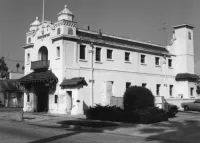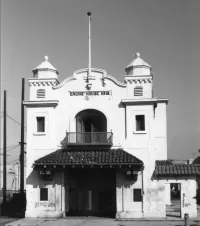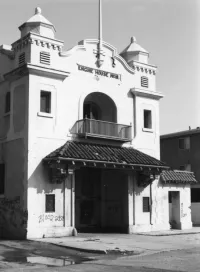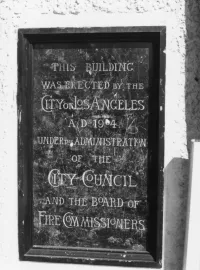Share what you know,
and discover more.
Share what you know,
and discover more.
Oct 29, 1982

-

- Charmaine Bantugan
Engine House No. 18 - National Register of Historic Places
Statement of Significance: Engine House No. 18 is significant for its age, association with a prominent Los Angeles architect, its virtually unaltered condition, as an excellent example of its style, and as one of the oldest remaining City of Los Angeles Fire Stations. A Los Angeles County Deed, recorded on November 9, 1904, describes the sale of the lot to the City of Los Angeles. The grantors, W.H. and Lou Niswanger, sold the property in consideration of the sum of $900. The cornerstone was laid in 1904 and construction continued throughout most of 1905. The structure was formally placed in commission on April 1, 1906. The cost of construction was $7,405. The architect, John Parkinson, chose the Mission Revival style for his design of the Engine House. Mr. Parkinson was one of the most prolific and important architects in Los Angeles during the first three decades of the twenty’s century. Numbered among his most important early works are the Jacoby Building, the Angeles Hotel, the Alexandria Hotel, the Braly Building, the King Edward Hotel, the Metropolitan Building, Bullock's Wilshire, the Rowan Building, the Washington Building, Citizen's National Bank, the L.A. Trust Building, the Los Angeles Athletic Club, and the Rosslyn Hotels. Engine House No. 18 is the best-known example of the Mission Revival style as designed "solely" by Parkinson. In addition, it was his first major commission of a public building. Later, more well known, examples of Parkinson's public architecture include the original Coliseum in Exposition Park; also, he was on the design team for Los Angeles City Hall. When it was placed into commission. Engine House. No. 18 was a "state-of-the-art" building. It was completed as part of a major expansion program of the Los Angeles Fire Department designed to upgrade the quality of fire protection in what were then outlying residential districts. Parkinson was an acknowledged expert in the field of fireproof construction and although the design of the building seems dated today, its masonry construction with the use of incombustible tile and chemically treated wood was a major advance at the time of its completion. In addition, the Engine House was originally equipped with some of the first steamers ever to be used in residential areas. It was not however, until 1921 that the Department completely motorized its equipment. Engine House No. 18 was also one of the last buildings designed entirely by Parkinson. In 1905, Parkinson went into partnership with G.E. Bergstrom. The firm of Parkinson & Bergstrom was one of the largest in Los Angeles for the ten years of its existence. Following the dissolution of the Bergstrom partnership, Parkinson joined into business with his son Dan. The firm of Parkinson & Parkinson was also extremely prolific, producing such buildings as the Title Insurance Building, Title Guarantee Building and the Wilshire Medical Building. A number of the Parkinson firm buildings are currently listed on the National Register. The majority of these are included in the Los Angeles Broadway and Spring Street Districts. The significance of Engine House No. 18, certainly the smallest in size of any of his known buildings, was not identified, however, until the recent completion of the Community Redevelopment Agency Architectural/Historical Survey of the Normandie 5 Project Area. The building was reviewed in the field by State Historic Preservation Office staff, who concurred with the consultant recommendation that it was a potential candidate for nomination. Today, the building is threatened by its vacant condition, vandalism and possible sale and demolition. In summary. Engine House No. 18 is significant as an excellent and virtually unaltered example of the Mission Revival style. It is also a pivotal building in the career of a prominent architect as it was Parkinson's first major public commission and was one of the last buildings designed entirely by John Parkinson. In addition, it was constructed as part of an important expansion program of the City of Los Angeles Fire Department and was of the most modern construction when first completed. It serves, therefore, as an important architectural and historical reminder of the history and growth of Los Angeles. And, as one of only a handful of fire stations remaining from horse and carriage days, it retains and presents a powerful sense of time and place.
Engine House No. 18 - National Register of Historic Places
Statement of Significance: Engine House No. 18 is significant for its age, association with a prominent Los Angeles architect, its virtually unaltered condition, as an excellent example of its style, and as one of the oldest remaining City of Los Angeles Fire Stations. A Los Angeles County Deed, recorded on November 9, 1904, describes the sale of the lot to the City of Los Angeles. The grantors, W.H. and Lou Niswanger, sold the property in consideration of the sum of $900. The cornerstone was laid in 1904 and construction continued throughout most of 1905. The structure was formally placed in commission on April 1, 1906. The cost of construction was $7,405. The architect, John Parkinson, chose the Mission Revival style for his design of the Engine House. Mr. Parkinson was one of the most prolific and important architects in Los Angeles during the first three decades of the twenty’s century. Numbered among his most important early works are the Jacoby Building, the Angeles Hotel, the Alexandria Hotel, the Braly Building, the King Edward Hotel, the Metropolitan Building, Bullock's Wilshire, the Rowan Building, the Washington Building, Citizen's National Bank, the L.A. Trust Building, the Los Angeles Athletic Club, and the Rosslyn Hotels. Engine House No. 18 is the best-known example of the Mission Revival style as designed "solely" by Parkinson. In addition, it was his first major commission of a public building. Later, more well known, examples of Parkinson's public architecture include the original Coliseum in Exposition Park; also, he was on the design team for Los Angeles City Hall. When it was placed into commission. Engine House. No. 18 was a "state-of-the-art" building. It was completed as part of a major expansion program of the Los Angeles Fire Department designed to upgrade the quality of fire protection in what were then outlying residential districts. Parkinson was an acknowledged expert in the field of fireproof construction and although the design of the building seems dated today, its masonry construction with the use of incombustible tile and chemically treated wood was a major advance at the time of its completion. In addition, the Engine House was originally equipped with some of the first steamers ever to be used in residential areas. It was not however, until 1921 that the Department completely motorized its equipment. Engine House No. 18 was also one of the last buildings designed entirely by Parkinson. In 1905, Parkinson went into partnership with G.E. Bergstrom. The firm of Parkinson & Bergstrom was one of the largest in Los Angeles for the ten years of its existence. Following the dissolution of the Bergstrom partnership, Parkinson joined into business with his son Dan. The firm of Parkinson & Parkinson was also extremely prolific, producing such buildings as the Title Insurance Building, Title Guarantee Building and the Wilshire Medical Building. A number of the Parkinson firm buildings are currently listed on the National Register. The majority of these are included in the Los Angeles Broadway and Spring Street Districts. The significance of Engine House No. 18, certainly the smallest in size of any of his known buildings, was not identified, however, until the recent completion of the Community Redevelopment Agency Architectural/Historical Survey of the Normandie 5 Project Area. The building was reviewed in the field by State Historic Preservation Office staff, who concurred with the consultant recommendation that it was a potential candidate for nomination. Today, the building is threatened by its vacant condition, vandalism and possible sale and demolition. In summary. Engine House No. 18 is significant as an excellent and virtually unaltered example of the Mission Revival style. It is also a pivotal building in the career of a prominent architect as it was Parkinson's first major public commission and was one of the last buildings designed entirely by John Parkinson. In addition, it was constructed as part of an important expansion program of the City of Los Angeles Fire Department and was of the most modern construction when first completed. It serves, therefore, as an important architectural and historical reminder of the history and growth of Los Angeles. And, as one of only a handful of fire stations remaining from horse and carriage days, it retains and presents a powerful sense of time and place.
Oct 29, 1982
Engine House No. 18 - National Register of Historic Places
Statement of Significance:Engine House No. 18 is significant for its age, association with a prominent Los Angeles architect, its virtually unaltered condition, as an excellent example of its style, and as one of the oldest remaining City of Los Angeles Fire Stations.
A Los Angeles County Deed, recorded on November 9, 1904, describes the sale of the lot to the City of Los Angeles. The grantors, W.H. and Lou Niswanger, sold the property in consideration of the sum of $900. The cornerstone was laid in 1904 and construction continued throughout most of 1905. The structure was formally placed in commission on April 1, 1906. The cost of construction was $7,405.
The architect, John Parkinson, chose the Mission Revival style for his design of the Engine House. Mr. Parkinson was one of the most prolific and important architects in Los Angeles during the first three decades of the twenty’s century. Numbered among his most important early works are the Jacoby Building, the Angeles Hotel, the Alexandria Hotel, the Braly Building, the King Edward Hotel, the Metropolitan Building, Bullock's Wilshire, the Rowan Building, the Washington Building, Citizen's National Bank, the L.A. Trust Building, the Los Angeles Athletic Club, and the Rosslyn Hotels. Engine House No. 18 is the best-known example of the Mission Revival style as designed "solely" by Parkinson. In addition, it was his first major commission of a public building. Later, more well known, examples of Parkinson's public architecture include the original Coliseum in Exposition Park; also, he was on the design team for Los Angeles City Hall.
When it was placed into commission. Engine House. No. 18 was a "state-of-the-art" building. It was completed as part of a major expansion program of the Los Angeles Fire Department designed to upgrade the quality of fire protection in what were then outlying residential districts. Parkinson was an acknowledged expert in the field of fireproof construction and although the design of the building seems dated today, its masonry construction with the use of incombustible tile and chemically treated wood was a major advance at the time of its completion. In addition, the Engine House was originally equipped with some of the first steamers ever to be used in residential areas. It was not however, until 1921 that the Department completely motorized its equipment.
Engine House No. 18 was also one of the last buildings designed entirely by Parkinson. In 1905, Parkinson went into partnership with G.E. Bergstrom. The firm of Parkinson & Bergstrom was one of the largest in Los Angeles for the ten years of its existence. Following the dissolution of the Bergstrom partnership, Parkinson joined into business with his son Dan. The firm of Parkinson & Parkinson was also extremely prolific, producing such buildings as the Title Insurance Building, Title Guarantee Building and the Wilshire Medical Building.
A number of the Parkinson firm buildings are currently listed on the National Register. The majority of these are included in the Los Angeles Broadway and Spring Street Districts. The significance of Engine House No. 18, certainly the smallest in size of any of his known buildings, was not identified, however, until the recent completion of the Community Redevelopment Agency Architectural/Historical Survey of the Normandie 5 Project Area. The building was reviewed in the field by State Historic Preservation Office staff, who concurred with the consultant recommendation that it was a potential candidate for nomination. Today, the building is threatened by its vacant condition, vandalism and possible sale and demolition.
In summary. Engine House No. 18 is significant as an excellent and virtually unaltered example of the Mission Revival style. It is also a pivotal building in the career of a prominent architect as it was Parkinson's first major public commission and was one of the last buildings designed entirely by John Parkinson. In addition, it was constructed as part of an important expansion program of the City of Los Angeles Fire Department and was of the most modern construction when first completed. It serves, therefore, as an important architectural and historical reminder of the history and growth of Los Angeles. And, as one of only a handful of fire stations remaining from horse and carriage days, it retains and presents a powerful sense of time and place.
Posted Date
Mar 15, 2022
Historical Record Date
Oct 29, 1982
Source Name
United States Department of Interior - National Park Service
Source Website
Delete Story
Are you sure you want to delete this story?













